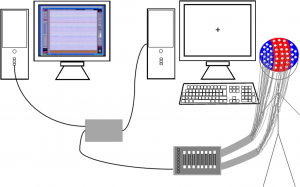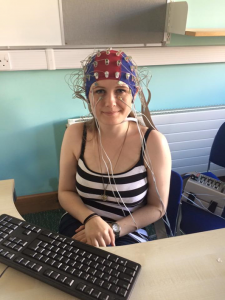For my PhD I am trying to find out how language is processed in the brain by combining methods from corpus linguistics and psycholinguistics. Specifically, I have extracted real language data from the British National Corpus and modified this data so that it can be presented to participants in an electroencephalography (EEG) experiment. In EEG experiments, electrodes are placed on a participant’s head and these electrodes detect some of the electrical activity that occurs in the participant’s brain in response to particular stimuli. EEG experiments are frequently conducted in Lancaster’s Psychology Department but they have not yet been conducted in the Department of Linguistics and English Language, so it’s really exciting to try out this method which is new to the department.
When conducting an EEG experiment, I start by taking head measurements and then placing a headcap on the participant’s head. This headcap contains 64 electrode holders which I fill with conductive gel before placing an electrode into each one. I also attach some additional electrodes behind the ears and around the eyes. Once all of the electrodes are in place, the stimuli is displayed to the participant on a computer screen. This stimuli consists of sentences that are presented word-by-word, as well as true/false statements that are presented as whole sentences. Participants just need to read the word-by-word sentences and respond to the true/false statement by pressing either the ‘T’ or the ‘F’ key on the keyboard. While they’re doing this, the electrodes detect some of the electrical activity that is happening in the brain, and this information is sent to another computer which displays the electrical activity as a continuous waveform. The setup of the experiment can be seen in the diagram below.
Throughout my PhD I will be conducting a series of experiments starting with a pilot study. In my pilot study, the experiment itself lasts for just 10 minutes but it can take me up to an hour to attach all of the electrodes. This preparation time should decrease as I carry it out on more and more participants.
I have already conducted several practice runs of my experiment with other postgraduate students. For example, Gillian Smith, another PhD research student in CASS, agreed to take part in one of my practice runs and here she describes her experience as a participant:
“Getting to be involved in Jen’s experiment was a great opportunity! Having never participated in such a study before, I found the whole process (which Jen explained extremely well) very interesting. I particularly enjoyed being able to look at my brainwaves after, which is something I have never experienced. Likewise, having electrodes on my head was a lovely novelty.”
I am currently looking for 15 native speakers of English to take part in my pilot study.
If you are interested in taking part in this experiment please email j.j.hughes@lancaster.ac.uk for more information.


